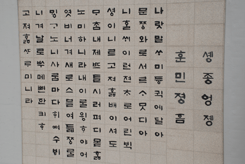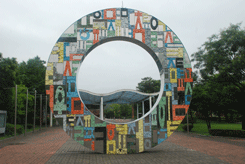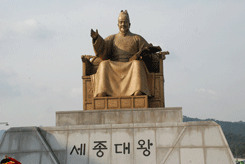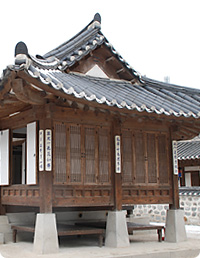Hanok
 |
 |
 |
Hangeul (Korean words)
Koreans use Korean alphabet, Hangeul. Each character of Hangeul represents its own sound. Hangeul was invented in 1443 in a document titled Hunminjeongeum by King Sejong and promulgated in 1446. His invention principle of Hangeul expressed in his book Hunminjeongum is as follow. "Being of foreign origin Chinese characters are incapable of capturing uniquely Korean meanings. Therefore, many common people have no way to express their thoughts and feelings. Out of my sympathy for their difficulties I have invented a set of 28 letters. The letters are very easy to learn and it is my fervent hope that they improve the quality of life of all people." However the privileged aristocrats continued to use Chinese characters thus Hangeul faced opposition by the literary elite. Having survived harsh time, Hangeul finally became the official script of Korea following the Gabo Reform of 1894.
Today, four letters are no more in use. Hangeul has 24 basic letters of 10 vowels and 14 consonants. The Hangeul is vertically and horizontally symmetrical and sytematic in sound by adopting the ligature principle, which is adding lines to strengthen the sound and combining consonants and vowels. The form of each consonant is based on the shape of the vocal organs used to produce them. Hangeul is not to be written in a single character alone but letters into syllabic blocks. At first, the basic consonants were ㄱ, ㄴ, ㅁ, ㅅ, ㅇ. A syllable consists of the initial, the medial, and the final in a way that the consonant comes first and the final while the vowel the medial. The design of the medial letters is that the vowels are derived from various combinations of the following three components: ㆍ ㅡ ㅣ. Here, symbolically stands for the sun in heaven, ㅡ stands for the flat earth, and ㅣ stands for an upright human. They correspond with the five main linguistic groups, velar, alveolar, bilabial, dental and glottal. Other 12 consonants were created by adding dots or lines, using the system to strengthen the sound in the same linguistic groups of consonants the same vocal organ. The total number of combination letters of Hangeul is 11,172 from 가 to 힣. Hangeul is also most adaptable to modern technology devices such as mobile phone or computer.
The following letters and clusters of letters are found in the modern script:
14 consonant letters: ㄱ g, ㄴ n, ㄷ d, ㄹ l/r, ㅁ m, ㅂ b, ㅅ s, ㅇ null/ng, ㅈ j, ㅊ ch, ㅋ k, ㅌ t, ㅍ p, ㅎ h
5 double ("tense") consonants: ㄲ kk, ㄸ tt, ㅃ pp, ㅆ ss, ㅉ jj
11 consonant clusters: ㄳ gs, ㄵ nj, ㄶ nh, ㄺ lg, ㄻ lm, ㄼ lb, ㄽ ls, ㄾ lt, ㄿ lp, ㅀ lh, ㅄ bs
6 vowel letters: ㅏ a, ㅓ eo, ㅗ o, ㅜ u, ㅡ eu, ㅣ i
4 iotized vowels (with a y): ㅑ ya, ㅕ yeo, ㅛ yo, ㅠ yu
5 (iotized) diphthongs: ㅐ ae, ㅒ yae, ㅔ e, ㅖ ye, ㅢ ui
6 vowels and diphthongs with a w: ㅘ wa, ㅙ wae, ㅚ oe, ㅝ wo, ㅞ we, ㅟ wi
In addition, there are numerous obsolete letters, as well as a number of sequences which are no longer used. Some of these were only ever used for transcribing Chinese.
13 obsolete consonants
10 obsolete double consonants
66 obsolete clusters of two consonants
17 of three consonants
1 obsolete vowel ㆍarae-a ('sub-a'; still used in the Jeju dialect and sometimes as a substitute for ㅏ a in logos and advertisements)
44 obsolete diphthongs and vowel sequences
The four iotated vowels are derived by adding a short stroke to the basic vowel. They are counted as part of the 24 letters of the alphabet because the iotating stroke is not a letter on its own. In fact, there is no letter for y in Hangeul.
Of the consonants, ㅊ chieut, ㅋ kieuk, ㅌ tieut, and ㅍ pieup are aspirated derivatives of ㅈ jieut, ㄱ giyeok, ㄷ digeut, and ㅂ bieup, respectively, formed by adding an extra stroke to the unaspirated letters.
These are also counted as separate letters of the alphabet, as the aspirating stroke is not a letter on its own.The doubled consonants, which are used in South Korea, are also counted as separate letters of the alphabet.
The modern consonants have two-syllable names, with the consonant coming both at the beginning and end of the name, as follows:
| Consonant | Name |
|---|---|
| ㄱ | giyeok (기역) |
| ㄴ | nieun (니은) |
| ㄷ | digeut (디귿) |
| ㄹ | rieul (리을) |
| ㅁ | mieum (미음) |
| ㅂ | bieup (비읍) |
| ㅅ | siot (시옷) |
| ㅇ | ieung (이응) |
| ㅈ | jieut (지읒) |
| ㅊ | chieut (치읓) |
| ㅋ | kieuk (키읔) |
| ㅌ | tieut (티읕) |
| ㅍ | pieup (피읖) |
| ㅎ | hieut (히읗) |
The double consonants are named with the word 쌍 ssang, meaning "twin" or "double", or with 된 doen in North Korea, meaning "strong". Thus:
Letter |
South Korean Name |
|---|---|
| ㄲ | ssanggiyeok (쌍기역) |
| ㄸ | ssangdigeut (쌍디귿) |
| ㅃ | ssangbieup (쌍비읍) |
| ㅆ | ssangsiot (쌍시옷) |
| ㅉ | ssangjieut (쌍지읒) |
The names of the vowel letters are simply the vowel itself, written with the null initial ㅇ ieung and the vowel being named. Thus:
| Letter | Name | Letter | Name |
|---|---|---|---|
| ㅏ | a (아) |
ㅐ | ae (애) |
| ㅑ | ya (야) |
ㅒ | yae (얘) |
| ㅓ | eo (어) |
ㅔ | e (에) |
| ㅕ | yeo (여) |
ㅖ | ye (예) |
| ㅗ | o (오) |
ㅘ | wa (와) |
| ㅛ | yo (요) |
ㅙ | wae (왜) |
| ㅚ | oe (외) |
||
| ㅜ | u (우) |
ㅝ | wo (워) |
| ㅠ | yu (유) |
ㅞ | we (웨) |
| ㅟ | wi (위) |
||
| ㅡ | eu (으) |
ㅢ | ui (의) |
| ㅣ | i (이) |
Sample text in Korean (Hangeul only
모든 인간은 태어날 때부터 자유로우며 그 존엄과 권리에 있어 동등하다. 인간은 천부적으로
이성과 양심을 부여받았으며 서로 형제애의 정신으로 행동하여야 한다.
Sample text in Korean (Hangeul and Hanja)
모든 人間은 태어날 때부터 自由로우며 그 尊嚴과 權利에 있어 同等하다. 人間은 天賦的으로
理性과 良心을 賦與받았으며 서로 兄弟愛의 精神으로 行動하여야 한다.
Transliteration
Modeun Inganeun Taeeonal ttaebuteo Jayuroumyeo Geu Joneomgwa Gwonrie Isseo Dongdeunghada. Inganeun Cheonbujeogeuro Iseonggwa Yangsimeul Buyeobadasseumyeo Seoro Hyungjeaeui Jeongsineuro Haengdonghayeoya handa.
Translation
All human beings are born free and equal in dignity and rights. They are endowed with reason and conscience and should act towards one another in a spirit of brotherhood.
(Article 1 of the Universal Declaration of Human Rights)
The Revised Romanization of Korean (Roman letter notation of national language) is the official Korean language Romanization system in South Korea proclaimed on July 7, 2000 by Ministry of Culture, Sports and Tourism, replacing the older McCune-Reischauer system. The new system eliminates diacritics in favour of digraphs and adheres more closely to Korean phonology than to a suggestive rendition of Korean phonetics for non-native speakers.
The Revised Romanization limits itself to only the English alphabet (apart from limited, often optional use of the hyphen).






